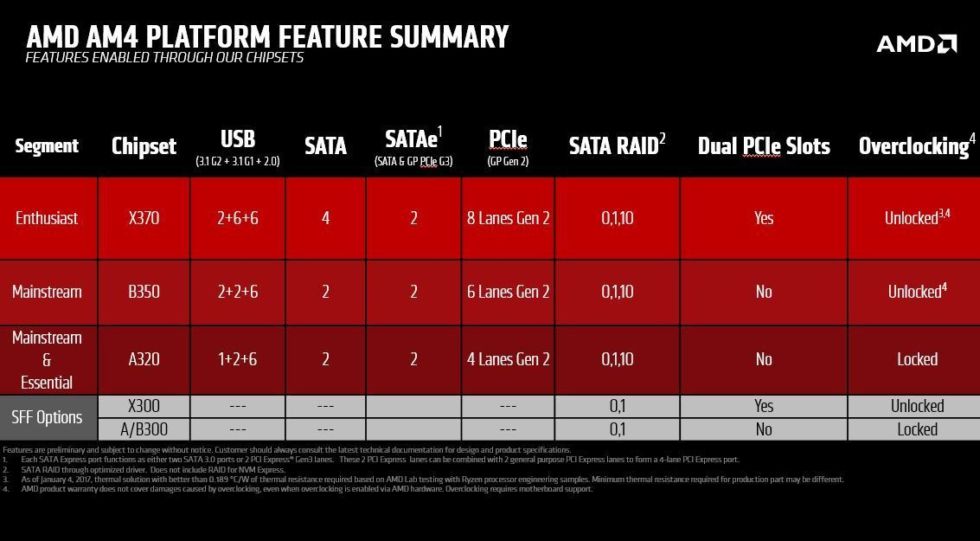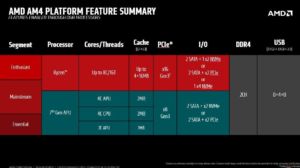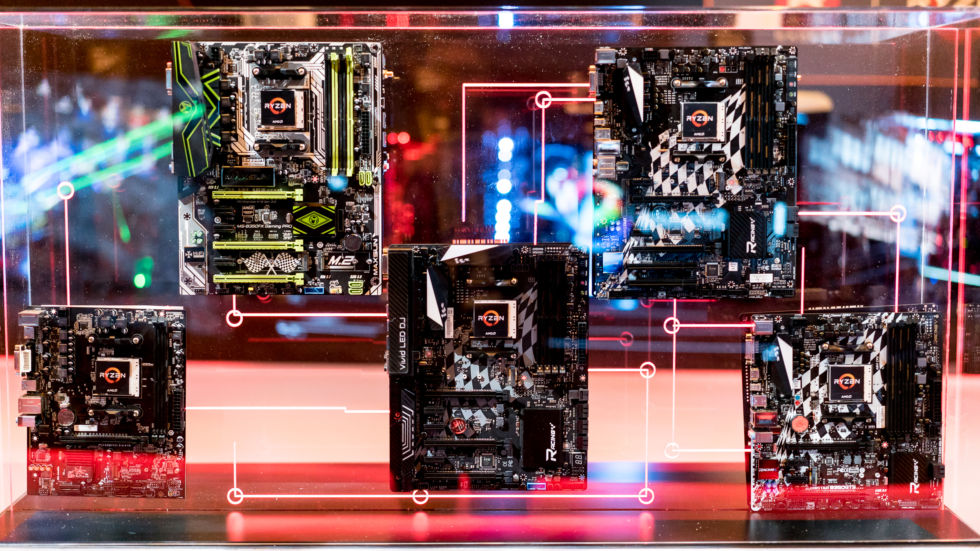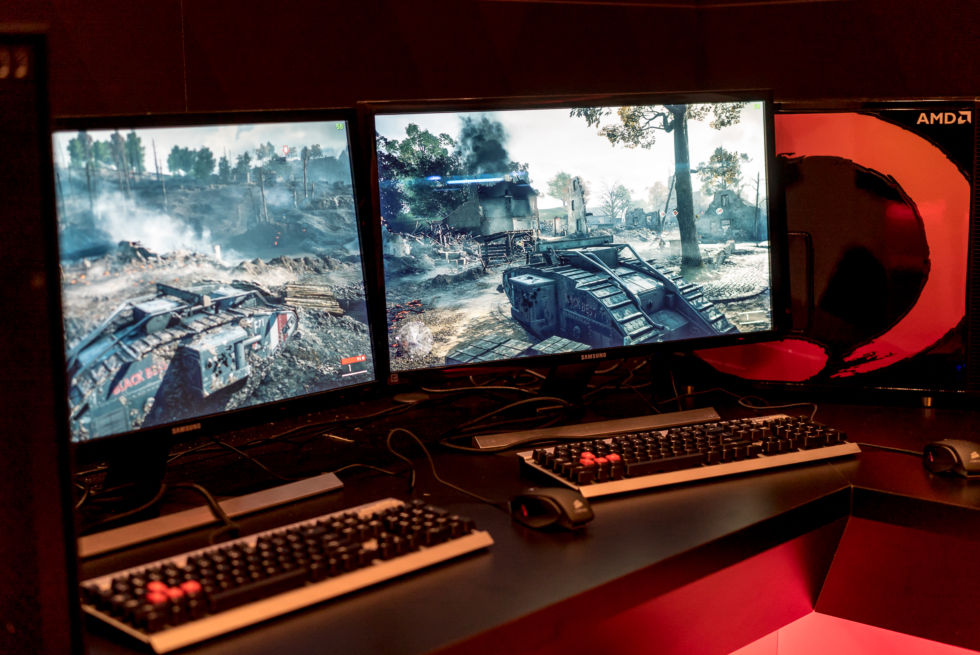
During AMD's "New Horizons" live stream, which served as a coming out party for the Ryzen CPU, the company showcased a brand new performance demo. It pitched a stock Intel Core i7 6900K processor—an eight-core Broadwell-E chip that retails for just shy of £1,000/$1,100—against an eight-core Ryzen CPU. Both chips were tasked with transcoding a short video clip into the "Apple TV 3" preset in Handbrake, a notoriously CPU-heavy workload that scales well across several cores. The result, according to AMD's demo, was a completion time of 54 seconds for Ryzen and 59 seconds for Broadwell-E; Ryzen was about 10 percent faster.
But the real kicker was that while the Broadwell-E chip ran with its standard boost enabled (up to 3.7GHz), the Ryzen chip was locked at its base clock of 3.4GHz. Not only did AMD claim to have caught up with Intel's multithreaded performance, it claimed to have surpassed it—and with TDP of just 95W compared to Intel's 140W.
Naturally, the Internet cried foul. Flick through the various subreddits dedicated to Zen, AMD, and Intel, and you'll find all manner of conspiracy theories about how AMD artificially capped performance on the 6900K by using a sub-par air cooler (it used the Intel-recommended part), or how there were differences in the video files used in the demo. Not all of these criticisms are without merit, of course. For example, it's not clear whether the Intel chip could have reached its full boost with all cores under heavy load. Or why not just lock the Intel chip at 3.4GHz for a straight IPC (instructions-per-clock) comparison?
Despite these concerns, AMD has shown enough of Ryzen to make it an exciting product. For the last five or so years, Intel has remained unchallenged in just about every segment of the PC market, and improvements over time have slowed to a crawl. Its latest chip, the Kaby Lake i7-7700K is an incredibly marginal upgrade over its Skylake predecessor. Even a six-year-old Sandy Bridge i7-2600K can still hold its own when overclocked.
Ryzen might just be the kick in the butt that the market needs—and thus, AMD is now working as hard as possible to convince the sceptical masses that Ryzen is more than just a tech demo, that Ryzen is a real product that will be on shelves before the end of March 2017.
Motherboards galore
To that end, AMD wheeled out its motherboard partners at CES, along with 16 of the 50 or so products that will launch alongside Ryzen. All the usual suspects are present and correct, including heavy hitters like Asus, MSI, and Gigabyte. What's most notable about the lineup is just how varied it is. AMD suffered from a lack of support with its AM3 chipset, resulting in a monolithic product line. AM4 changes that. For enthusiasts, there's X370, which brings together dual-channel DDR4, Radeon Crossfire, and Nvidia SLI support (yes, these boards are SLI certified), multiple SATA and M.2 slots, native USB 3.1 Gen 2, overclocking support, and the styling (read: gaudy l33t gamer) and build quality typical of premium motherboards.
The only nitpick with X370 is that it has only eight PCIe lanes of its own. Coupled with the 24 PCIe lanes of Ryzen—16 for graphics, four for NVMe, and four to communicate with the chipset—users have 32 lanes to work with. That's comparable with Intel's mainstream chips but lacking compared to Broadwell-E. Crossfire and SLI certainly aren't as appealing as they used to be (and if Nvidia's recent moves are anything to go by, SLI isn't long for this world), but the rapid proliferation of PCIe-based storage means PCIe lanes are quickly becoming a prized commodity.


A step down from X370 is B350, which also supports overclocking but drops some USB and SATA ports, two PCIe lanes, and Crossfire/SLI support. A320 drops even more USB and SATA ports, another two PCIe lanes, and overclocking support. Expect the latter to be priced very reasonably indeed. Perhaps most interesting, though, is the X300 chipset. This is a chipset designed explicitly for mini-ITX motherboards. After the longest time, AMD's high-end chips will find a home in small form factor PCs—and with just a 95W TDP, an eight-core Ryzen will make for an imposing SFF workstation and gaming rig. With X300, AMD has ditched all motherboard-based IO, leaving just the USB, SATA, and 24 PCIe lanes that are part of the Ryzen core.
Curiously, the 4 PCIe lanes a Ryzen chip would typically use to communicate with the motherboard I/O can be repurposed by motherboard makers to add an extra M.2 slot or more SATA ports. Intel uses PCIe, too, but via a proprietary DMI interface (AMD uses SMI) that can't be accessed by motherboard makers.
AMD has an impressive product stack with AM4, but more than that it shows just how invested in Ryzen the industry is. With the lacklustre Bulldozer architecture, high-end AMD chipsets were thin on the ground. Now, there are multiple chipsets, premium features and designs, and support from the biggest players in the industry. Cooling companies like Noctua have even pledged to send out new mounting brackets (AM4 is slightly wider than AM3) for free to anyone with a Ryzen receipt. AMD might not have revealed the product SKUs or the boost clocks of Ryzen itself, but there's no doubt that the ecosystem surrounding it is ready for launch.

That said, AMD has promised that all Ryzen chips—whether that's the octa-core used in its demos or the rumoured hexa- and quad-core parts—are multiplier unlocked for overclocking, which is another departure from the mostly locked chips from Intel. The only limiting factor is the chipset.
Even then, there may be performance boosts on offer for those with exotic cooling as part of its "Extended Frequency Range" (XFR) feature.
"A lot of processors have pre-programmed clock speed voltage tables," explained AMD's Robert Hallock at CES. "We don't. This is very algorithmic. We analyse power consumption limits, thermal limits, silicon utilisation limits, and out of that boundary, if none of those limits are being met, you can just keep raising clock speed until one of them is. Then you level off the boost and then try to sustain it as long as possible. The system is smart enough to know what's going on inside itself, and adaptive enough to prevent sudden drops in clock speeds."
Time for a change
What's most impressive, though, is just how quick AMD has been to respond to critics. When commenters worried that Ryzen might bottleneck high-end graphics card performance like AMD's older CPUs, the company showed a demo of Ryzen running Battlefield 1 on an Nvidia Titan X Pascal, with a frame rate identical to that of a stock i7-6900K system with its own Titan X. When commenters asked what the value of an eight-core system would be compared to a quad, AMD showed how it would enable gamers to play a game like Dota 2 and stream it to Twitch simultaneously at the highest settings with even less dropped frames and delay than an i7-6900K (a feat AMD says is down to its more efficient inter-core communication).
I tried those demos myself at CES, and it's hard to not be impressed. Until Ryzen lands in the hands of reviewers and the public, though, we should take everything with a large pinch of salt and a donning of the great scepticism hat. After all, this is a company that has a vast history of over promising and under delivering.

But there's a confidence around Ryzen that's been missing from AMD's CPU division for the longest time. Having seen Ryzen in action and just how hard AMD is working to make it a success, I'm hopeful that it will go some way towards helping the company's shaky financials from the past few years and that AMD might finally have a chip that moves desktop CPU performance forward.
Assuming Ryzen's performance really is that good, the big question is: how far will AMD go down the price/performance rabbit hole? At CES, the company openly asked journalists what it should be priced at. Price an eight-core Ryzen at around £400/$500 and you bring down the cost of eight-core chips to that of a six-core—a solid move for consumers, but not one that will greatly affect mainstream performance. Price it the same as a quad-core i7-7700K—about £300/$330—and you dramatically shake up the industry. The decision is yet to be made.
"There are a lot of discussions going on," says Hallock. "We're capturing the feedback. We wanna take share, we wanna be the best price/performance option, we wanna be the first on people's minds. That's part of the bounding box for pricing discussions as well as paying off the R&D investment... We're looking at what Intel does—and we're not gonna do that. We think people want the choice, and need the choice. The market needs the choice—hopefully we can turn it around."
Listing image by Mark Walton
reader comments
238